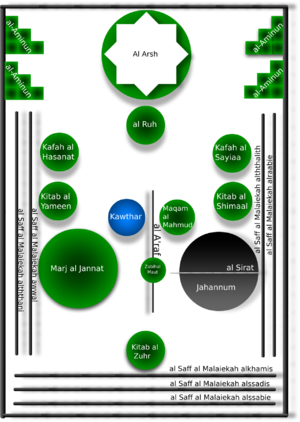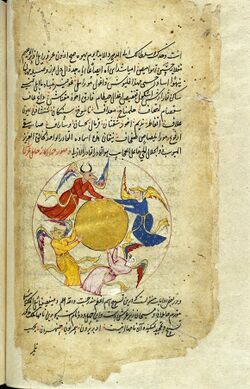Religion:Throne of God in Islam
Al-ʽArsh (Arabic: العرش Al-ʿArsh 'the Throne') is the throne of God in Islamic theology. It is believed to be the largest of all the creations of God.[1][2]
Quran
The Quran mentions the throne some 25 times (33 times as Al-ʽArsh), such as in verse Q10:3 and Q23:116:
Indeed, your Lord is Allah, who created the heavens and the earth in six days and then established Himself above the Throne (ʽArsh), arranging the matter [of His creation]. There is no intercessor except after His permission. That is Allah, your Lord, so worship Him. Then will you not remember? - Yunus 10:3
And it is He who created the heavens and the earth in six days - and His Throne had been upon water - that He might test you as to which of you is best in deed. But if you say, "Indeed, you are resurrected after death," those who disbelieve will surely say, "This is not but obvious magic." - Hud 11:7
So Exalted be Allah, the True King - None has the right to be worshipped but He - Lord of the Supreme Throne! - al-Mu’minoon 23:116
The Quran depicts the angels as carrying the throne of God and praising his glory, similar to Old Testament images.
...those who bear the Throne, and all who are round about it, sing the praises of their Lord and believe in Him and ask forgiveness for those who believe. - Quran 40:7
...and you shall see the angels going round about the Throne glorifying the praise of their Lord; and judgment shall be given between them with justice, and it shall be said: all praise is due to God, the Lord of the Worlds. - Quran 39:75
The Ayat al-Kursi (often glossed as "Verse of the footstool"), is a verse from Al-Baqara, the second sura of the Quran, and is regarded[by whom?] as the book's greatest verse. It references the Kursi (كرسي) which is different from the Throne [عرش], and also God's greatest name, Al-Hayy Al-Qayyoom ("The Living, the Eternal").[3]
Hadith
Sunni
Sunni prophetic hadith establish that The Throne is above the roof of Al-Firdaus Al-'Ala, the highest level of Paradise where God's closest and most beloved servants in the hereafter shall dwell.[4]
Sunni scholars of hadith have stated that Muhammad said the reward for reciting Ayatul Kursi after every prayer is Paradise,[5] and that reciting it is a protection from the devil.[6]
Characteristics
- Its breadth has been described as the Seven Heavens is like a ring in a desert in relation to the Kursi or the footstool of Allah, and likewise the Kursi is like a ring in a desert in relation to "the Throne",[7] On the authority of Abu Dharr al-Ghifari, he said: [8] I said to the Prophet: O Messenger of God, whatever has been revealed to you is greater. He said: Ayat al-Kursi, then he said: O Abu Dharr, what are the seven heavens with the Kursi except like a ring thrown into a desert land, and the preference of the Throne over the Chair is like the preference of the desert over the ring.
- The Throne is the highest of all creatures, and it was primarily on the water.[9] The Quran says:
، and on the authority of Abdullah ibn Masud he said:[10]and His Throne was upon the waters.—Sura Hud:7The distance between the highest heaven and the world is five hundred years, and between the Kursi and the water as well, and the Throne is above the water, and God is above the Throne, nothing of your deeds is hidden from Him. - It is the heaviest of all creatures.[9] On the authority of Juwayriya bint al-Harith she said:[11]that the Prophet (Peace be upon him), came out of her house tomorrow when he prayed the morning prayer, while she was in her mosque. Then he came back after he left, while she was sitting. He said: “Are you still in the state in which I left you?” She said: Yes. The Prophet said (Peace be upon him) “I have said four words after you, three times.
- that he has lists;[12] As in the Hadith:[13] People will be stunned, so I will be the first to wake up, and then I will see Musa overwhelmed - or he said: taking hold of one of the pillars of the Throne.
Views
Sufi

Sufi Muslims believe God created the throne as a sign of his power and not as place of dwelling.[15]
Abu Mansur al-Baghdadi (d. 429/1037) in his al-Farq bayn al-Firaq (The Difference between the Sects) reports that 'Ali ibn Abi Talib, said: "God created the Throne as an indication of His power, not for taking it as a place for Himself."[16] The vast majority of Islamic scholars, including Sunnis (Ash'aris, Maturidis and Sufis), Mu'tazilis, and Shi'is (Twelvers and Isma'ilis) believe the Throne (Arabic: العرش al-'Arsh) as a symbol of God's power and authority and not as a dwelling place for Himself,[17][18][19] others describe it as an allegory, and many others said that the heart of the believer is the Throne of Allah (قلب المممن عرش الله), a quote criticized by Salafi Muslim scholars.[20]
Salafi
Some Islamic sects, such as the Karramis and the Salafis/Wahhabis believe that God has created it as a place of dwelling.[21][22][23]
Bearers of the Throne
Bearers of the Throne or ḥamlat al-ʽarsh (حملة العرش) are a group of angels in Islam. The Quran mentions them in Quran 40:7 and Quran 69:17. In Islamic traditions, they are often portrayed in zoomorphic forms. They are described as resembling different creatures: An eagle, a bull, a lion and a human.[citation needed] Other hadiths describes them with six wings and four faces.[24] While according to a hadith transmitted from At-Targhib wat-Tarhib authored by ʻAbd al-ʻAẓīm ibn ʻAbd al-Qawī al-Mundhirī, the bearers of the throne were angels who shaped like a rooster, with their feet on the earth and their nape supporting the Throne of God in the highest sky.[Notes 1] a number modern Islamic scholars from Imam Mohammad Ibn Saud Islamic University, and other institutes Yemen and Mauritania also agreed the soundness of this hadith by quoting the commentary from Ibn Abi al-Izz who supported this narrative.[25]
These four angels are also held to be created from different elements: One from light, one from fire, one from water and one from mercy. It is also said they are so large that a journey from their earlobes to their shoulders would take seven hundred years.[26] According to various Islamic tafsir scholars which compiled by Islamic University of Madinah and Indonesian religious ministry, the number of these angels will be added from four into eight angels during the Day of Resurrection.[27] This interpretation were based on Qur'an chapter Al-Haqqa Quran 69:17.[27]
According to Al-Suyuti who quoted a Hadith which transmitted by Ibn al-Mubarak, archangel Israfil is one of the bearer of the throne.[28]
See also
Note
- ↑ The hadith were: "...Allah, the most exalted, has permitted me to speak of a rooster whose legs have separated the earth, and its neck is bent under the throne..." through the narration of Abu Hurairah by Abd al-Qawi al-Mundhiri through Al-Qadi Abu Ya'la. The Hadith were judged as authentic and sound by numerous hadith scholars such as by Nur al-Din al-Haythami in his work, Majma al-Zawa'id, Al-Tabarani in his work, Al-Mu'jam al-Awsat, Mustafa al-Adawi in Sahih Al-Ahadith Al-Qudsi and also by Muhammad Nasiruddin al-Albani in his work Silsalat al-Hadith as-Sahihah[25] It also commented as safe as it is also supported by other Hadith from another chain from Jabir ibn Abd Allah in the Sunan Abu Dawood.[25]
References
- ↑ Islam Issa (2016). Milton in the Arab-Muslim World. Taylor & Francis. p. 97. ISBN 9781317095927. https://books.google.com/books?id=gColDwAAQBAJ.
- ↑ Tafseer al-Qurtubi, 8/302, 303.
- ↑ Book 004, Number 1768: (Sahih Muslim).
- ↑ Saheeh al-Bukhaari (#2581).
- ↑ Sunnan Nasai'i al Kubra, (6/30), At-Tabarani; Al-Kabeer (8/114).
- ↑ Saheeh Al Bukhari - Volume 3, Book 38, Number 505.
- ↑ ما هو الفرق بين عرش الربّ وكرسيه islamqa.info
- ↑ Ibn Taymiyyah in Majmoo’ al-Fatawa 6/ 556.
- ↑ 9.0 9.1 خلق العرش والكرسي ـ موقع الكلم الطيب
- ↑ Al-Tawhid p.: 105, and Al-Bayhaqi in the Names and Attributes p.: 401, and Ibn al-Qayyim in Mukhtasar al-Sawa’iq al-Mursalah p.:435 Al-Dhahabi in Al-Ulwu li’l-Ali al-Ghaffar p. 64.
- ↑ Sahih Muslim (2726).
- ↑ مقال: ما جاء في ذكر عرش الرحمن
- ↑ >Agreed upon From the hadith of Abu Hurairah, Sahih al-Bukhari (4211), Sahih Muslim (2373).
- ↑ Begley, Wayne E. The Garden of the Taj Mahal: A Case Study of Mughal Architectural Planning and Symbolism, in: Wescoat, James L.; Wolschke-Bulmahn, Joachim (1996). Mughal Gardens: Sources, Places, Representations, and Prospects Dumbarton Oaks, Washington D.C., ISBN:0884022358. pp. 229–231.
- ↑ The Creed of Imam Al-Tahawi.
- ↑ "Allah's Establishment Over the Throne". As-Sunnah Foundation of America. http://sunnah.org/2012/05/05/allahs-establishment-over-the-throne/.
- ↑ Mohammad Ibrahim Teymori. "The Creed of Imam Tahawi". pp. 20–24. http://www.afghanicc.com/books/TheCreedofImamTahawi-4thSpecialEdition.pdf.
- ↑ Shahrur, Muhammad (2009) (in en). The Qur'an, Morality and Critical Reason: The Essential Muhammad Shahrur. BRILL. ISBN 9789047424345. https://books.google.com/books?id=OwqwCQAAQBAJ&q=arsh+of+allah+metaphor&pg=PA161.
- ↑ Yılmaz, Hakkı (14 June 2020) (in en). The Division By Division English Interpretation of THE NOBLE QUR'AN in The Order of Revelation. Hakkı Yılmaz. p. 566. https://books.google.com/books?id=ceZVDwAAQBAJ&q=arsh+of+allah+metaphor&pg=PA566.
- ↑ Jabbar, Abdunur Ibn Abdul (7 April 2015) (in bn). আকীদাহ্ সম্পর্কিত কতিপয় গুরুত্বপূর্ণ মাস'আলাহ্ - বাংলা - আব্দুননূর ইবন আব্দুল জাব্বার (Some Important Mas'alahs Regarding Aqidah - Bengali - Abdunur Ibn Abdul Jabbar). Islamhouse.com. p. 7. https://d1.islamhouse.com/data/bn/ih_books/single2/bn_aqidah_somporkito_kotipoy_guruttopurno_masalah.pdf. Retrieved 6 January 2023.
- ↑ Rifai, Sayyid Rami Al (2016) (in en). The Light Of Allah In The Heavens and The Earth: The Creation Of The Atom (24:35) and The Physics Of Spirituality. Sunnah Muakada. https://books.google.com/books?id=N2LcCwAAQBAJ&q=arsh+of+allah&pg=PA130.
- ↑ Elias, Jamal J. (1995) (in en). The Throne Carrier of God: The Life and Thought of 'Ala' ad-dawla as-Simnani. SUNY Press. ISBN 9780791426111. https://books.google.com/books?id=zqc01-Y6XfMC&q=Throne+of+allah&pg=PA113.
- ↑ al-Din, Khwajah Kamal (1963) (in en). The Islamic Review. Woking Muslim Mission and Literary Trust. https://books.google.com/books?id=vljoAAAAMAAJ&q=arsh+of+allah+metaphor.
- ↑ Stephen Burge (2015). Angels in Islam: Jalal al-Din al-Suyuti's al-Haba'ik fi Akhbar al-malik. Routledge. p. 265. ISBN 978-1-136-50473-0.
- ↑ 25.0 25.1 25.2 "رتبة حديث: أذن لي أن أحدث عن ملك من ملائكة الله من حملة العرش..." (in ar). Saudi Arabia: Al-Imaam Muhammad Bin Saud Islamic University. 2013. https://www.islamweb.net/ar/fatwa/205000/%D8%B1%D8%AA%D8%A8%D8%A9-%D8%AD%D8%AF%D9%8A%D8%AB-%D8%A3%D8%B0%D9%86-%D9%84%D9%8A-%D8%A3%D9%86-%D8%A3%D8%AD%D8%AF%D8%AB-%D8%B9%D9%86-%D9%85%D9%84%D9%83-%D9%85%D9%86-%D9%85%D9%84%D8%A7%D8%A6%D9%83%D8%A9-%D8%A7%D9%84%D9%84%D9%87-%D9%85%D9%86-%D8%AD%D9%85%D9%84%D8%A9-%D8%A7%D9%84%D8%B9%D8%B1%D8%B4.
- ↑ Syrinx von Hees (2002) (in german). Enzyklopädie als Spiegel des Weltbildes: Qazwīnīs Wunder der Schöpfung: eine Naturkunde des 13. Jahrhunderts. Otto Harrassowitz Verlag. p. 283. ISBN 978-3-447-04511-7.
- ↑ 27.0 27.1 "Surat An-Nazi'at ayat 5; Tafsir Juz Amma" (in Indonesian, Arabic). Islamic University of Madinah; Ministry of Religious Affairs (Indonesia); Ministry of Islamic Affairs, Dawah and Guidance. https://tafsirweb.com/11209-surat-al-haqqah-ayat-17.html.
- ↑ Al-Suyuti (2021). Muhammad as Said Basyuni, Abu Hajir; Yasir, Muhammad. eds (in id). Misteri Alam Malaikat (Religion / Islam / General). Pustaka al-Kautsar. pp. 29–33, 172. ISBN 9789795929512. https://books.google.com/books?id=iDxQEAAAQBAJ. Retrieved 6 February 2022. "Quoting Ibnul Mubarak from a book of az-Zuhd; ad Durr al-Manshur, chain narration from Ibnul Mubarak to Ibn SHihab (1/92)"


